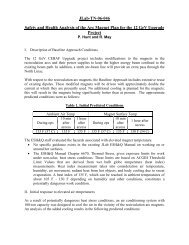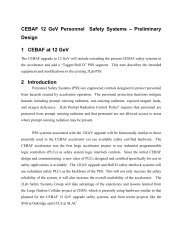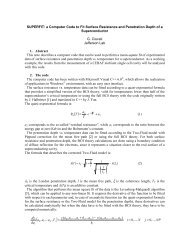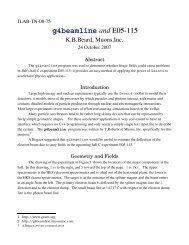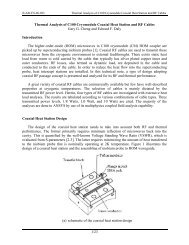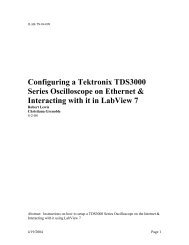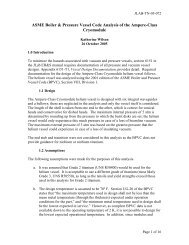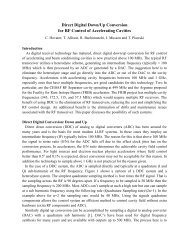Workshop on Polarized Electron Sources and Polarimeters
Workshop on Polarized Electron Sources and Polarimeters
Workshop on Polarized Electron Sources and Polarimeters
You also want an ePaper? Increase the reach of your titles
YUMPU automatically turns print PDFs into web optimized ePapers that Google loves.
FIGURE 3. Sequence of activati<strong>on</strong>s in the HABS apparatus<br />
maximum q.e. seems to remain c<strong>on</strong>stant for a few activati<strong>on</strong>s, even without further<br />
treatment, before a reducti<strong>on</strong> is observed, see activati<strong>on</strong>s 12-16. The behavior of the<br />
SL’s c<strong>on</strong>cerning hydrogen treatment is similar to bulk GaAs. The DBR cathode 7-396<br />
has achieved the highest q.e., yielding more than 10% at 650 nm. 7-395/7-396 cathodes<br />
were transferred to our test source, a 7-395 went to the source at the MAMI accelerator.<br />
Results in Producti<strong>on</strong> source: These tests were performed with a high intensity laser<br />
system operated at wavelengths of 785 <strong>and</strong> 802 nm, close to the maximum polarizati<strong>on</strong><br />
resp<strong>on</strong>se of the cathode. We observed a ten times increased q.e. at low intensities for<br />
the HABS treated sample if compared with an untreated <strong>on</strong>e. Moreover, the saturati<strong>on</strong><br />
effects at high intensities had disappeared resulting in a factor 50 gain of maximum<br />
current. Tests were performed at a q.e. of 0.6% <strong>and</strong> 200 µA of average current (density<br />
of ≈ 200mA/cm 2 ) without showing n<strong>on</strong>linear effects. Beam polarizati<strong>on</strong> was measured<br />
with a Mott polarimeter that offers a reproducibility of about 1%, whereas the absolute<br />
accuracy is ∆P/P = ±4%. After <strong>on</strong>e week of operati<strong>on</strong> at the accelerator the q.e. had<br />
dropped by a relative 15% which resulted in a relative increase of polarizati<strong>on</strong> by 6%,<br />
yielding an absolute value of P = 85.5 ± 3.2%. This value is within the highest ever<br />
observed at our producti<strong>on</strong> source.<br />
Results in test source: Comparis<strong>on</strong>s of maximum polarizati<strong>on</strong> for treated/untreated<br />
samples were d<strong>on</strong>e at the test source. We found no difference (at the 3% (relative) level)<br />
between the different samples <strong>on</strong>ce the initial q.e. of the hydrogen cleaned <strong>on</strong>e was<br />
slightly reduced (see above). This provides evidence that hydrogen treatment has no<br />
detrimental effect <strong>on</strong> the bulk properties of the superlattice structure. A tunable laser<br />
was used for spectrally resolved measurements. The lower curve in figure 4 shows the<br />
results for an untreated sample of 7-395, the upper <strong>on</strong>e those from a fresh <strong>on</strong>e measured<br />
at St. Petersburg. The results for a hydrogen treated sample are close to the St. Petersburg<br />
measurements. Again, saturati<strong>on</strong> effects were present for the n<strong>on</strong> treated sample which<br />
would make the discrepancy in figure 4 even larger at high laser intensities. The DBR



